Agriculture Tools Market Research: 2032
The Global Agriculture Tools Market was valued at $2114 million in 2022 and is projected to reach $4846 million by 2032, registering a CAGR of 8.7% from 2023 to 2032.
A vast variety of tools, machinery, and equipment designed for use in diverse agricultural operations are produced, distributed, and sold as part of the marketing of agricultural tools. These tools are crucial for improving crop cultivation, animal management, and other farming operations' efficiency, productivity, and sustainability for farmers and agricultural professionals.
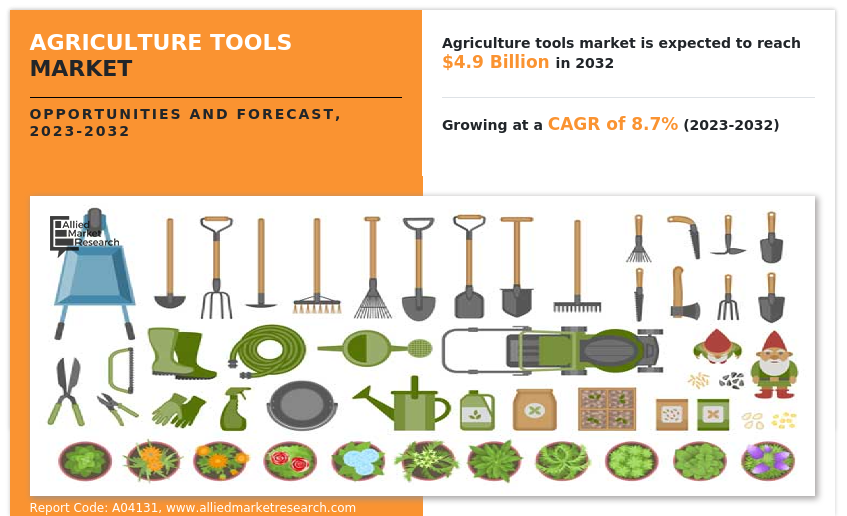
Market Dynamics
Increase in city population typically follows increase in urbanization, which increases consumer demand for fresh food and promotes the growth of agriculture tools industry. To meet the nutritional needs of increasing number of people who move into urban areas, there is also a greater need to produce more food. A change in eating habits is also correlated with urbanization. Urban residents often eat a more diverse diet that contains a higher percentage of perishable and distributed processed items. In response to this shift in consumer food tastes, farmers must adjust and diversify their crops and growing techniques.
For instance, the global bank forecasts that grain stocks would rise by around 60 million tonnes in 2023–2024. To support the efficient production of fruits, vegetables, and other commodities that may be processed, additional agricultural technologies and techniques are being developed.
However, agriculture tool manufacture often involves the use of several alloy steel kinds. For instance, chromium vanadium steel, an alloy tool steel made of chromium (Cr) and vanadium (V), is frequently used in hoes, axes, saws, sickles, and other tools as it has greater strength and toughness than carbon steel. The price of steel, which is a key component of agriculture tools, determines the overall cost of the tool. The World Steel Association predicts that the demand for steel will rise by 4.5% in 2021 and by 2.2% in 2022.
Rise in steel prices could result from such a rise in demand. In addition, fluctuations in energy costs have an impact on the price of steel as well as the cost of producing tools. Therefore, fluctuations in raw material and energy prices could limit the expansion of the agriculture tools market size.
Moreover, the development of agricultural operations is supported by the governments of many different countries, who also provide grants for the purchase of seeds and equipment. In addition to helping to ensure enough food production, the subsidies also help to protect farmer incomes, lower the inflation rate for food commodities, and strengthen the agricultural industry. To increase agricultural production, developing countries like India offer a variety of subsidies, debt cancellation programs, and other such incentives.
For instance, the Indian government provides several programs for agricultural equipment, including Central Farm Machinery Training & Testing, online farm machinery monitoring, loan-cum-subsidy for the purchase of tractors, pump sets, and power tillers, as well as engineering training services for the use of cutting-edge agricultural equipment. Thus, all these variables working together are projected to present profitable prospects for the growth of the global market during the forecast period.
Furthermore, several commodities, including food items, oil, and gas, saw a surge in price due to the Russia-Ukraine conflict. With supply chain interruptions, there are now more expensive shipping costs, fewer available containers, and less warehouse space. Since there have been delays in shipments and congestion, certain ports have been closed, and orders are being retracted, which influences industry and consumers globally. The decline in investor confidence has also increased the stock market volatility. Economic instability has risen due to the strained commercial ties between Russia, Ukraine, and their different trading partners. Hence, all such factors have reduced export possibilities.
On the contrary, Governments from many countries provide assistance for the growth of agricultural industries, including financial aid for the purchase of machinery and seeds. The subsidies help to ensure enough food production, lower the inflation rate for food commodities, protect farmer incomes, and strengthen the agricultural industry. To increase agricultural production, developing countries such as India offer a variety of subsidies, debt cancellation programs, and other such incentives.
For instance, The Department of Agriculture, Cooperation, and Farmers' Welfare is expected to get INR 1.24 lakh crore ($15.9 billion) from the Union Budget 2022–23. To ensure that newer technology, such as enhanced crop seeds, new breeds and strains of livestock and fish, and improved production and protection methods reach farmers, a nationwide network of 729 Krishi Vigyan Kendras has been set up at the district level. Therefore, rise in sustainable farming methods, government initiatives, and concern from extension services to increase crop production is anticipated to contribute to the agriculture tools market growth during the forecast period.
Segmental Overview
The agriculture tools market is segmented into type, distribution channel, application, and region. By type, the market is divided into shovel, rake, wheelbarrow and other. The rakes segment dominated the market in 2022. By distribution channel, the market is divided into instore and online. The in-Store segment dominated the market in 2022. By application, it is classified into farms and gardens. The farming segment dominated the market in 2022.‐¯ Region-wise, the agriculture tools market is analyzed across North America (the U.S., Canada, and Mexico), Europe (Germany, the UK, France, Italy, and rest of Europe), Asia-Pacific (China, India, Japan, South Korea, and rest of Asia-Pacific), and LAMEA (Latin America, Middle East, and Africa).
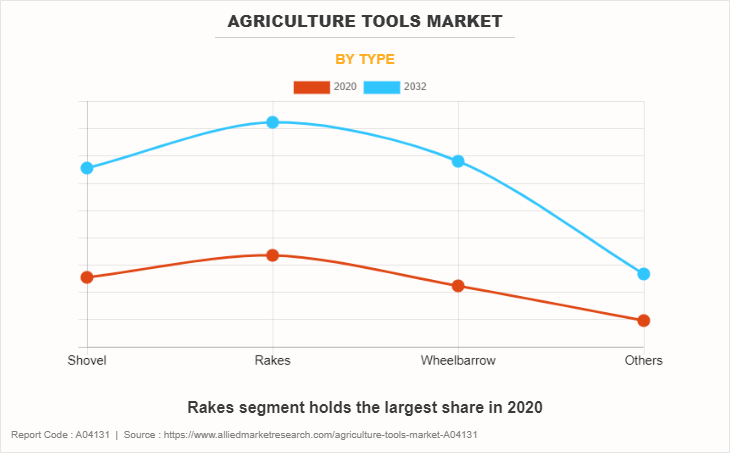
By Type,
The market is divided into shovel, rake, wheelbarrow, and other. As the global population continues to grow, there is rise in demand for food and agriculture products. This leads to increase in agriculture activities, including planting, harvesting, and soil preparation, all of which require shovel and similar tools. In addition, a rake is a garden or yard tool consisting a long handle, typically made of wood or metal, with the series of tines are teeth attached to one end.
Moreover, rise in population increases the demand for the agriculture sector and livestock business for meat. Wheelbarrow is used for variety of applications such as carrying pesticides, grains, and other materials. Rake is expected to exhibit the largest revenue contributor during the forecast period. Wheelbarrow is expected to exhibit the highest CAGR share in the applications of segment in the agriculture tools market during the agriculture tools market forecast period.
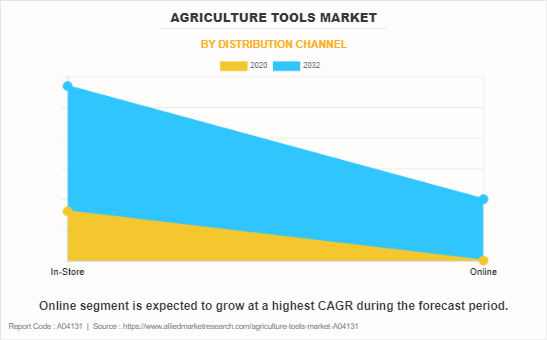
By Distribution Channel,
The market is divided into online and in store. Items purchased from a physical store can be properly inspected before buying. Thus, customers can easily ensure the appropriate quality of the agriculture hand and power tools. In addition, the lead time from placing the order for tools and receiving them is effectively zero. In addition, with the increasing penetration of the Internet, many industrial, non-industrial, and consumer products including hand and power tools are available through the online mode. The in store segment is expected to be the largest revenue contributor during the forecast period, and the online segment is expected to exhibit the highest CAGR share in the product segment in the agriculture tools market during the forecast period.
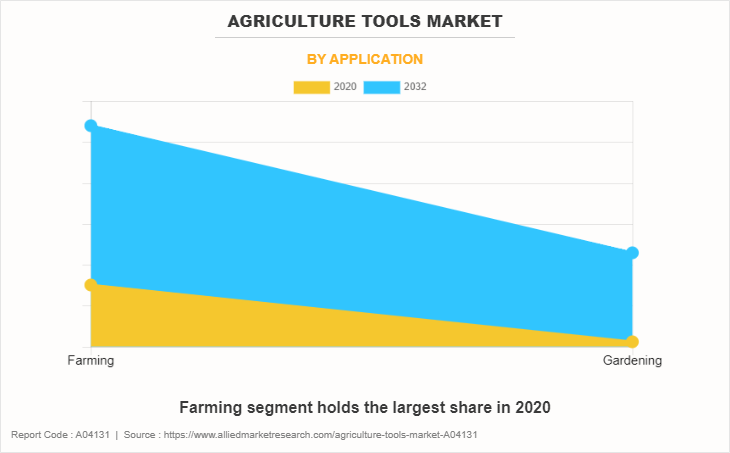
By Application,
The market is divided into farming and gardening. Farming tools include a wide range of tools or equipment used in farming and agriculture activities, which are designed to assist farmers in various tasks related to crop cultivation, livestock management, and other agriculture operations. In addition, Garden tools are hand handled tools, especially designed for use in gardening, horticulture, and landscaping activities. Farming segments are expected to be the largest revenue contributor during the forecast period, and the gardening segment is expected to exhibit the highest CAGR share in the propulsion system segment in the agriculture tools market during the forecast period.
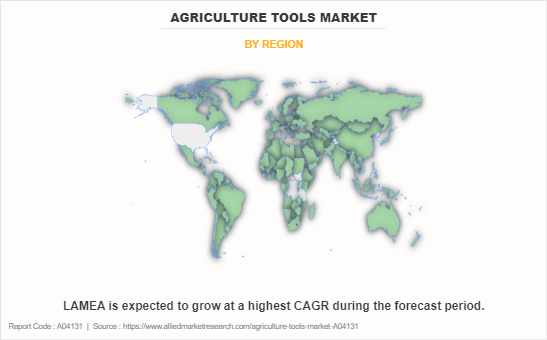
By Region:
The agriculture tools market is analysed across North America, Europe, Asia-Pacific, and LAMEA. In 2022, Asia-Pacific held the highest revenue in agriculture tools market share. And LAMEA is expected to exhibit the highest CAGR during the forecast period.
Competition Analysis
The key companies having significant market share profiled in the report include, The key companies profiled in the agriculture tools market report include Deere & Company, Fiskars Group, Stanley Black & Decker, Inc., Truper, S.A. de C.V., CHILLINGTON TOOL COMPANY, Apex Tool Group, LLC., Bellota Agrisolutions, The Toro Company, Falcon Garden Tools, and DeWit tools. Major companies in the market have adopted acquisition, product launch, business expansion, and other strategies as their key developmental strategies to offer better products and services to customers in the agriculture tools market.
Key Benefits For Stakeholders
- This report provides agriculture tools market outlook along with quantitative analysis of the market segments, current trends, estimations, and dynamics of the agriculture tools market analysis from 2020 to 2032 to identify the prevailing agriculture tools market opportunities.
- The market research is offered along with information related to key drivers, restraints, and opportunities.
- Porter's five forces analysis highlights the potency of buyers and suppliers to enable stakeholders make profit-oriented business decisions and strengthen their supplier-buyer network.
- In-depth analysis of the agriculture tools market segmentation assists to determine the prevailing market opportunities.
- Major countries in each region are mapped according to their revenue contribution to the global market.
- Market player positioning facilitates benchmarking and provides a clear understanding of the present position of the market players.
- The report includes the analysis of the regional as well as global agriculture tools market trends, key players, market segments, application areas, and market growth strategies.
Agriculture Tools Market Report Highlights
| Aspects | Details |
| Market Size By 2032 | USD 4.9 billion |
| Growth Rate | CAGR of 8.7% |
| Forecast period | 2020 - 2032 |
| Report Pages | 220 |
| By Type |
|
| By Distribution Channel |
|
| By Application |
|
| By Region |
|
| Key Market Players | Falcon Garden Tools, Bellota Agrisolutions, Chillington Tools, Truper, S.A. de C.V., Stanley Black & Decker, Inc., Fiskars Group, The Toro Company, Apex Tool Group, LLC., Deere & Company, Robert Bosch GmbH |
Analyst Review
Increasing trend of small scale and urban farming is driven by factors such as growing interest in organic and locally sourced produce. This drives the demand for compact and versatile tools suitable for home gardening and other small farms. However, the market faced constraints related to affordability and limited access to modern tool for small scale farmers. in addition, development of cost effective, ergonomics, small agriculture tools, as well as the expansion of the distribution of network to reach smallholder farmer in emerging market.Moreover, educational program and training incentive can enhance the adoption of these tools, making small scale farming more efficient and sustainable.
The global agriculture tools market was valued at $1,810.8 million in 2020, and is projected to reach $4,846.0 million by 2032, registering a CAGR of 8.7% from 2023 to 2032
The forecast period considered for the global agriculture tools market is 2022 to 2031, wherein, 2022 is the base year, 2022 is the estimated year, and 2032 is the forecast year.
The latest version of global agriculture tools market report can be obtained on demand from the website.
The base year considered in the global agriculture tools market report is 2022.
The key companies profiled in the agriculture tools market report include Deere & Company, Fiskars Group, Stanley Black & Decker, Inc., Truper, S.A. de C.V., CHILLINGTON TOOL COMPANY, Apex Tool Group, LLC., Bellota Agrisolutions, The Toro Company, Falcon Garden Tools, and DeWit tools.?
The top ten market players are selected based on two key attributes - competitive strength and market positioning
The report contains an exclusive company profile section, where leading companies in the market are profiled. These profiles typically cover company overview, geographical presence, market dominance (in terms of revenue and volume sales), various strategies and recent developments.
By application, the Farming segment was the largest revenue generator in 2022.
Loading Table Of Content...
Loading Research Methodology...



